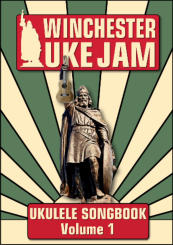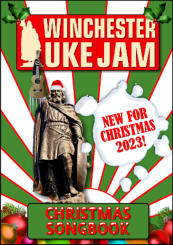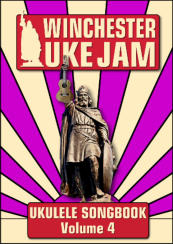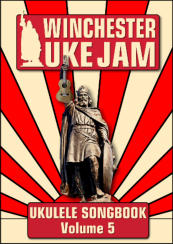Here are links to the current songbooks. Click on a cover to go to the
relevant songbook page where you can download the songs.
SONGS
HOME

Latest Songs
The Winchester Uke Jam at the Time Ring in Andover
SONGS
Andrews Sisters Medley
Added 27/08/2015
Alexander’s Medley
Added 27/08/2015
Tipperary Medley
Added 27/08/2015
We’ll Meet Again
Added 27/08/2015
Download a zip file of the
entire collection of songs
as individual .pdfs.














Download a zip file of the
entire collection of songs
for the PG Songbook



Ukulele Songsheets - a cautionary warning! by Stuart Jebbitt
“This Sheet must be wrong...it’s different to this other one I’ve got”......
Nearly all Ukulele bands work from song sheets, incorporating the lyrics and
chords of a song and perhaps one or two other
pointers, such as a strum pattern.
However, they are not an exact science!
I’ve seen numerous versions of the same songs in various Ukulele band
songbooks and on websites, and no two versions are
ever exactly alike.
Some are in different keys, with different strum patterns and sometimes they even
have differing chords and lyrics.
This doesn’t necessarily mean one is ‘right’ and another is ‘wrong’, just different.
Some versions will leave out some of the less
essential passing chords, and some will use jazzier chords than normal.
Some put the chord changes in line with the lyrics, others just above the lyrics.
Sometimes where the actual chord changes
fall in a particular song can be a matter for debate, especially with a song in which the vocals can be interpreted in
different
ways. The Instrumental backing isn’t always necessarily directly glued to
the vocal line.
In short, Song sheets are not Music, they are simply shorthand guides on how to
play a song that you already know, or have
access to a recording of.
Creating them inevitably involves compromise - You have to find a balance
between including enough information to help the
group play the song, but
without cramming in so much information that you simply end up overloading
them.
I’ve seen Song sheets that map out the precise number of bars each chord is
strummed for, with dozens of forward slashes
decorating the page!
The danger here is you end up not actually feeling the music.
It becomes a counting exercise and not a music exercise. Much better just to get to
know the song over time and feel the
chord changes that way.
Also....It’s good do bear in mind the subtle difference between performing and playing.
For example, If we were to teach a group of classical piano students a piece like
Beethoven’s ‘Fur Elise’, we would use
standard musical notation (bass clefs and
trebles clefs et al) and by the end everyone would learn to perform it in more or
less
the same way.
This is because music notation is very precise in nature, and designed to cover all
the variables, including expression. ‘Fur
Elise’ pre-dates recorded sound, and so it
had to be that way in order to be performed consistently wherever it travelled to.
With pop/rock music it is very much about playing a song. The genre is much
freer and encourages variation. No two cover
versions of a song are ever the same
and nor are they expected to be.
In classical music you tend to learn and then perform a piece, whereas in pop
music you tend to play it.(You ‘play’ in band,
because it is PLAY - exploratory, expressive, and fun)
It is fine to mess around with all the variables, the tempo, the rhythm pattern, the
feel, and the format, and make it your own,
especially with repertoire not
originally intended for the Ukulele.
Lastly, whilst you can buy Pop and Rock Songbooks written out in standard music
notation, these are rarely created by the
artist themselves, and are inevitably an
abridged compromise. Bearing in mind that the average commercial pop
recordings
can easily include 40-80 separate instrumental tracks, it has to be,
unless you wish to create songbooks that are 4 foot in
length!
Below are some extra songs not included in the songbooks.
Click on the pdf icon to download the relevant file


